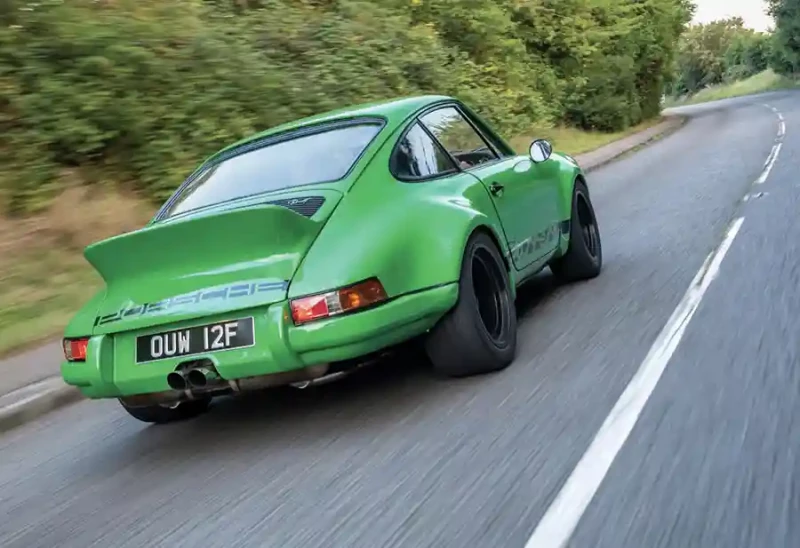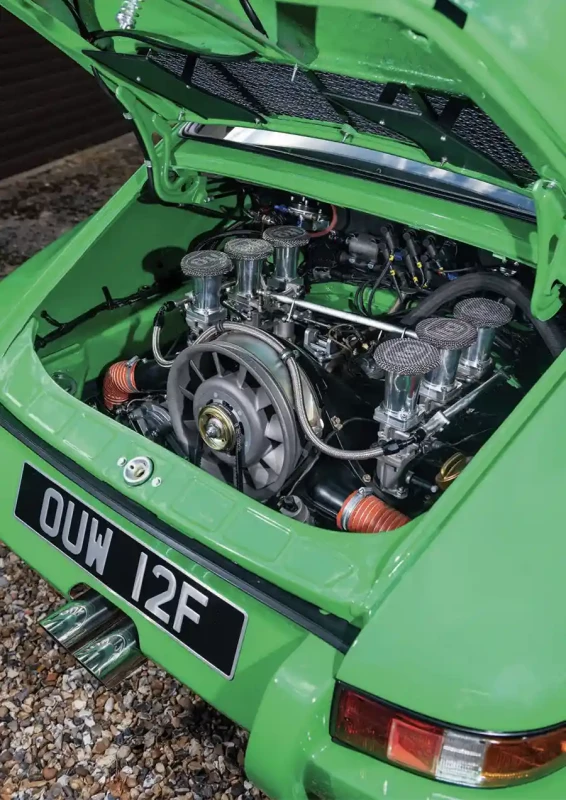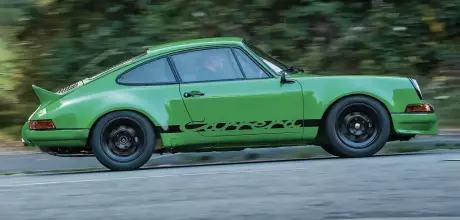1968 Porsche 911 L Coupe SWB transformed into a screaming 3.2-litre widebody finished in Viper Green
The latest restomod to roll out of Rindt Vehicle Design is this short-wheelbase 1968 911 L coupe transformed into a screaming 3.2-litre widebody finished in Viper Green...
Words Dan Furr
Photography Dan Sherwood
GREEN WIDE MONSTER
A 1968 911 L with Carrera 3.2 power.

How far gone would a classic 911 have to be for you to consider it done for? It’s a question anybody involved in salvaging an air-cooled Porsche from years of neglect has asked themselves, but the truth of the matter is this: no matter how decayed, decrepit or dilapidated an old sports car might be, there is always the chance of turning a rusty bucket of bolts into a show queen. Of course, determining whether to walk away or embark on a journey of restoration comes down to how much time, money and determination you possess, as well as the availability of not only spare parts, but also a specialist with expertise in the field of historic sports car restoration. Fortunately, for the owner of this late short-wheelbase 911, Maidenhead-based Porsche restoration and customisation specialist, Rindt Vehicle Design, was able to resurrect the car following it being left out to pasture for fifteen years by a previous custodian holding the best of intentions, but no available funds or the skills to carry out the necessary work to bring the Porsche back to its best.
STEALTHILY INSTALLED SPEAKERS AND SMARTPHONE CONNECTIVITY TO A KENWOOD HEAD UNIT HIDDEN IN THE GLOVEBOX

“It took us two days to extract this 911 from the lean-to it was inhabiting on agricultural land in Essex,” says former golf pro and Rindt Vehicle Design founder, Brian Richardson. “The seller took ownership many years ago and intended to work on the car as a longterm restoration project.” Unfortunately, as is the case with many well-meaning enthusiasts who find themselves in possession of an old Porsche in need of attention, the scale of the job was deemed far greater than anticipated, leading the car to a state of suspended animation until Brian and his team arrived with the offer of a new lease of life.
Named after the legendary German-born racing driver, Jochen Rindt, winner of the 1965 24 Hours of Le Mans and posthumously awarded the 1970 Formula One driver’s title following his death behind the wheel at Monza that year, Rindt Vehicle Design conducts its work from within the environs of beautiful old character buildings on farmland located a stone’s throw from Windsor. Employing a team of engineers and craftsmen carrying a huge amount of experience in the restoration of premium marque vehicles, not least classic Porsches, the Rindt Vehicle Design team prides itself on being able to manufacture the rarest and most obscure parts — meeting or exceeding OEM standards — when original components can’t be saved.

The company was incorporated in 2017, though Brian has been restoring and modifying air-cooled Porsches since his teenage years. Decades of experience in the field and an acute knowledge of variations in model specification, as well as a desire to create historic Porsches with their own personalities, led him to establish Rindt Vehicle Design following his retirement from sport. Fastforward to the present day and he’s in charge of turning out extraordinary air-cooled classics, from nut-and-bolt restorations of 912s and 911s rebuilt to original specification, to wholly bespoke builds incorporating a raft of custom bodywork and powertrain equipment. There’s also a Rindt Vehicle Design motorsport division, as evidenced by various race-ready Boxsters, Caymans and even a fire-breathing 450bhp wide-body 964 on site. Dressed in the team’s distinctive orange and white livery, these cars are a familiar sight at Porsche Club Great Britain motorsport events.
PORSCHE PARTNERSHIP
“Restoring a classic Porsche is a collaboration,” explains Brian. “We work with our clients to conceive preferred design and engineering specification, offering advice regarding the appropriate selection of donor car and assistance in the purchase process, where applicable. We can design and build one-off body panels and trim, and we can craft interiors which either whisper understatement or throw away the rulebook. Ultimately, we’ll deliver an automotive masterpiece, built to last, from which an owner can derive endless pleasure.”

Any restorer promoting their wares would say the same, but proof is in the, er, Porsches, and there’s no shortage of restored and reimagined Zuffenhausen metal at Rindt Vehicle Design vindicating Brian’s sales pitch. As we wander through timber-beamed workshop after timber-beamed workshop, we’re presented with a veritable feast of works in progress, from freshly painted body shells in the early stages of vehicle reassembly, to comprehensively redeveloped chassis ready to accept massive power from bespoke engines, including the company’s recently perfected four-litre supercharged aircooled flat-six. The theme of forced induction continues with the presence of a beefed-up twin-turbocharged boxer undergoing the final stages of assembly in a dedicated engine assembly room.
Maybe luck is on our side, but on the occasion of our visit, each of the restored 911 bodies on display — some coupe, some Targa — is finished in an eye-popping, camera-friendly colour. “During the course of the past seventy-five years, Porsche has developed more than a thousand paint shades,” Brian observes. “We have the eye and experience to match even the most obscure factory paint colour, as well as to develop one-off specials. Crucially, we endeavour to imitate the finish of pre-1980 non-cellulose, water-based paints used by Porsche from the manufacturer’s very earliest days.” Achieving a flawless finish, and in accordance with Brian’s obsessive attention to detail, Rindt Vehicle Design makes use of the celebrated multi-stage Novol paint process, the only paint system created specifically for classic motor vehicle restoration. The technology isn’t exclusive to customers commissioning full restoration, though. “Due to demand for our paint services, we recently opened a second paint shop,” Brian continues. “This gives us the capacity to accept cars from customers who might want nothing more than cosmetic correction, whether elimination of stone chips and other minor damage, or a thorough detail. Of course, we are more than happy to respray cars in their entirety, but our new paint booth gives us the opportunity to provide enthusiasts with a range of corrective services, all carried out to the same professional standard we apply to our extensive restoration projects.”
Among Rindt Vehicle Design’s most prized assets are its panel beaters. The age-old artisanal work of handbeating panels is a dying art, not to mention one at a serious premium in the industry, but as we walk around the firm’s generously-sized bodywork facility — paying host to another half a dozen 911 shells undergoing various stages of restoration and modification — it’s clear Brian has managed to attract a team well-versed in the intricacies of creating and shaping vintage automotive bodywork. As you’d expect, there’s an English Wheel on the go, but we also note three original 1960’s Celette jigs and pegs, ensuring factory-correct specifications are observed during full bare metal restoration and vehicle reassembly.
We’re treated to a sneak peek of hugely exciting projects due to be completed in the new year. We’ll reveal full details and showcase each car in coming issues of Classic Porsche, suffice to say even in its skeletal form, the pillarless 911 coupe we’re looking at promises to set show season alight following completion of the build. It’s one of Brian’s pet Porsche passion projects and will serve to demonstrate the capabilities of Rindt Vehicle Design to prospective clients less than au fait with its output. The car is impressive enough even in this basic state — the more you look, the more you appreciate just how much work has gone into every aspect of the bodywork — but with the plans Brian has in store for this highly individual Neunelfer, we can’t help but feel the finished article will quickly become a calling card generating enquiries from marque enthusiasts wanting the very same treatment for their classic 911s.
There’s a dedicated trimming department on-site, too. “We have a network of material suppliers and manufacturers capable of recreating factory fabrics, but also the ability to produce entirely original concepts and designs to suit individual requirements,” Brian smiles. “Our team of in-house trimmers are experts in their field and can produce stunning interiors for all air-cooled Porsches.” Like we said earlier, everything is under one roof. Well, almost — there’s a fine selection of 911 and 912 sales cars waiting to be liberated from the courtyard circled by the workshops we’ve been exploring.
Demonstrating the ‘anything goes’ policy at Rindt Vehicle Design, a highly personalised 964 Carrera 2 finds itself parked next to a standard-specification 1973 911 Targa. Both cars have been subjected to full restoration. A small selection of water-cooled 911s makes itself known, led by a stunning 997 Sport Classic evocation. As you can tell, it’s very easy to get distracted by the high volume of outstanding Porsches in Brian’s custody, but we remind ourselves we’ve come to marvel at the company’s recently completed Viper Green short-wheelbase 911 restomod. Yes, the car pictured on these pages is the very same 911 Brian dragged from slumber in Essex. At the risk of presenting understatement of the century, it’s a changed a bit since then.
“It started life as a two-litre 1968 911 L, but the original engine was missing,” Brian recalls. “In its place was a two-litre flat-six manufactured in 1966.” The lack of ‘matching numbers’ meant any desire to maintain originality was dashed, but this proved a moot point when a Rindt Vehicle Design customer reached out with a request for a “more peppy” short-wheelbase 911 with aggressive looks. Following subsequent discussion between Brian and client, the decided specification centred around a wide body and an uprated Carrera 3.2 powerplant running independent throttle bodies. On the face of it, twelve months is a long time, but it’s the blink of an eye in the world of classic sports car restoration, making this 911’s year-long transformation from zero to hero nothing short of remarkable. The body was fully stripped to bare metal and expertly rebuilt, before being sprayed gorgeous green and dressed with a large ducktail and RS-style bumpers, the rear accommodating the tailpipes of a custom exhaust. As intended, the engine is a fully rebuilt 3.2-litre flatsix, but now benefits from Jenvey Dynamics individual throttle bodies. Founded in 1987, this world-famous throttle body and fuel injection system manufacturer has forged an enviable reputation for delivering highquality housings, spindles, butterflies, levers and fuel rails for all manner of road and race cars, including aircooled Porsches. The two-stud kit installed in the green machine’s engine bay comprises six of the Shropshire company’s SF throttle bodies, a specially balanced linkage kit, inlet manifolds, fuel rails, fuel rail mounts and a set of ninety-millimetre air horns. A three-stud version of the kit, which provides the host flat-six with improved performance, reliability and weight reduction, is available for the 964’s M64 flat-six.
SPARK SPREAD
This Rindt restomod’s throttle bodies are topped with ITG air filters. A custom panel along the bulkhead accommodates a coilpack feeding Magnecor competition ignition leads. Various motorsport-specification fuel system components inhabit the same space. The entire engine bay is completely spotless, so much so we’d go as far as saying better than new. This isn’t solely because it happens to be box fresh. “When you present a restomod in public, one of the first things people want to look at is the engine bay,” Brian asserts. “It is therefore of vital importance to ensure the flatsixes powering our bespoke 911s are housed in clean, uncluttered operating environments.”
Thanks in large part to the previously mentioned Novel paint process, the exterior is just as tidy, which sets the zingy Viper Green paintwork against black accents, as seen on the side stripes, engine lid grille, Porsche script decal, window frame brightwork and headlight rings. Oh, and those deep dish sixteen-inch Group 4 Wheels Campagnolo replicas, finished satin black and looking much larger than they actually are, primarily due to blending in with the fat sidewalls of their Porsche specific Yokohama A008P tyres. Step inside the cabin and you’ll find the reverse colour scheme — a sea of black is punctuated with flashes of bright green. “The interior needed to be subtle, pared down, a marked contrast to the car’s shouty bodywork,” Brian reasons.
The look was achieved with new RS-style seats, a dashboard trimmed to match and a custom-upholstered MOMO Prototipo Black Edition threespoke steering wheel. The rear seats have been retained in order for the car’s lucky owner to share driving experiences with his young family. Green flourishes come in the form of fabric door pulls, the Rindt Vehicle Design logo on the snooker ballesque gearknob (linked to a rebuilt Type 915 gearbox) and the period-style decoration of swish new Singerstyle dash dials. Look closely and you’ll see the speedo incorporates a digital odometer. It’s one of a few such examples of modern functionality hidden in this fiftyfive- year-old Porsche’s cockpit. “We installed electronic air-conditioning,” Brian says, proudly. The challenge was to keep the car looking vintage, as though it left the factory in its restored state. “We hid the system’s supporting equipment, which wasn’t as easy as it sounds. We then added system control switches above the dash strip, where buttons for the heated front and rear screens also reside.” A custom three-stage fan switch is incorporated into an original-look fresh air vent lever, while in-car entertainment is provided by stealthily installed JBL speakers and smartphone connectivity to a Kenwood head unit hidden in the glovebox.
Surprisingly, the suspension remains standard, albeit rebuilt. “The owner intends to use the car day to day, whenever the mood takes him,” Brian says. “The stock suspension is adjustable by way of torsion bars, but comfort is key. This isn’t a race car, and the lack of roll cage confirms access to the rear seats was important from the outset. Make no mistake, this 911 shifts down the road at fast pace, a result of the potent 3.2-litre engine doing its thing, but this was always intended to be a car as useful during commuting as it might be on a trackday, with emphasis on the former application.”
That this 911 spent such a huge amount of time in the doldrums and took only a year to be reborn as an eye-popping poster Porsche is credit to not only Brian’s clarity of vision, but also the large workforce at Rindt Vehicle Design, enabling the company to tackle multiple big-scale restoration projects simultaneously. This speaks nothing of sales car preparation and the team’s multiple engineering programmes. We can’t wait to see what rolls out of the workshop next.
Above The latest in what promises to be a long line of Rindt Vehicle Design 911 restomods — we can’t wait to sample the next one.
Above MOMO Prototipo Black Edition steering wheel certainly looks the part Facing page Every inch of the car is super-clean and uncluttered, creating the effect of a factory finish.
Above and below The owner’s intention is to use the car for commuting, as well as high days and holidays, meaning comfort is key.
Above The wheels are only sixteen-inchers, but look much bigger due to their matte black finish blending in with the fat tyre sidewalls.
THE ENGINE IS A FULLY REBUILT 3.2-LITRE FLAT-SIX, BUT NOW BENEFITS FROM JENVEY THROTTLE BODIES
THE AGE-OLD ARTISANAL WORK OF HAND-BEATING PANELS IS A DYING ART, NOT TO MENTION ONE AT A SERIOUS PREMIUM
Facing page Following fifteen years feeling sorry for itself under a lean-to, this 911 L was transformed into a wide-arched showstopper


